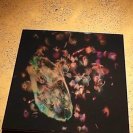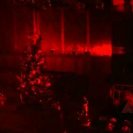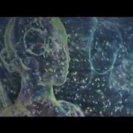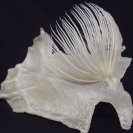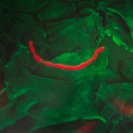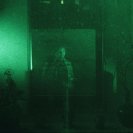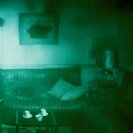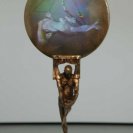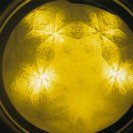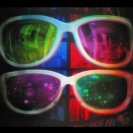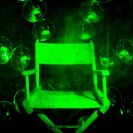Holographer, sculptor and performance artist, Paula Heatley Dawson was born in Brisbane in 1954. Her father, George, is an electrical engineer with a strong inventive streak; and her mother, Heatley, introduced Paula to the arts, especially opera. The diverse interests of both parents were a profound influence on their daughter, even before the family moved to Melbourne in 1966. Paula Dawson had studied ballet from an early age, and she now added Graham and Cunningham techniques to her repertory, and trained briefly with Ballet Victoria. Dance played a minor role in Dawson’s early career as an artist: influenced by Yves Klein, she danced on a roll of paper in paint-saturated shoes for her Painting Examination at the Melbourne State College, for which she was failed and had to repeat . Some years later, her first performance piece, Music and Lasers in Mazes (1977), united dance and light.
In Melbourne, where Dawson was awarded a Graduate Diploma in painting at the Royal Melbourne Institute of Technology (RMIT) in 1978, and a BA. in 1981 at Victoria College of the Arts, the 1970s were the hey-day of conceptual art, in which she was deeply interested at this time. Her first exhibited holograms, with an ironic use of the archetypal subject of scientific holograms, such as a toy train, shown at a student sculpture show in 1974, were intentionally installed so that the laser did not replay the image, but bore texts telling the viewer how they were made. Four years later she mounted a complex and essentially conceptual installation, The Difference between Tuesday and Thursday , also using texts, for a La Trobe University Sculpture Exhibition. Although the intellectual content of Dawson’s work became generally less obtrusive, the paradoxical relationship of real and virtual survived in her aesthetic for many years, emphasised in witty titles such as There’s No Place Like Home (1980), Are You There? (a portrait of Margaret Carnegie, OA, 1986), or To Absent Friends (1989).
At the same time as she was exploring these conceptual paradoxes, Dawson was growing more and more interested in wave-phenomena. She acquired an explosives license (still current), and made a number of sculptures by detonating charges under steel sheets on land or water ( Low Resistance , 1978), as well as a series of spectacular explosions in a quarry that were filmed by Scott Hicks forWomen Artists of Australia , 1982. The fascination with waves derived from a fascination with the interference-effects of light-waves, which are the basis of holography. Dawson showed regularly at the Mildura Sculpture Triennials between 1975 and 1982, sculpture proving an appropriate complement to another medium which at least simulated three dimensions. The quarry pieces were made in conjunction with high-speed filming, which allowed the disintegration of the rock to be both viewed in slow motion and also re-integrated, like reconstructing a holographic image.
Although it was conceived in the 1940s, holography had only become viable with the development of a coherent light source, the laser, in the1960s; and it only became cheap enough and technically simple enough to attract artists during the second half of that decade. So when Dawson exhibited her inscrutable hologram in 1974 she was effectively announcing the arrival of a new art medium in Australia. As a result, she was invited to make a larger work for the National Gallery of Victoria show 'Document Performance Video’ in 1975 , and was able to do so through a generous informal collaboration with the CSIRO National Measurement Laboratory, Sydney. Her solo show, 'Transparent Things’, at the RMIT Gallery in 1977, set Dawson’s continuing agenda as a holographer: to engage with the viewer’s experience of being through anomalies in everyday appearances. She supplied viewers with copies of a chapter from Nabokov’s novel of the same name, which included the significant passage:
'When we concentrate on a material object, whatever its situation, the very act of our attention may lead into the involuntary sinking into the history of that object. Novices must learn to skim over matter to stay at the exact level of the moment. Transparent things through which the past shines!’ (V. Nabokov, Transparent Things , Penguin Books, 1972, p.7)
The exhibition shared the distinction with George Gittoes (who was exhibiting holograms in Sydney that year), of presenting the public with the first substantial display of art-holograms in this country. But early holograms were small; they typically showed small objects in a shallow space; and of course the holograms still most familiar to us, such as security devices on credit cards, etc., are very small indeed. But Dawson was determined to work large, and to find the technical facilities to do so she had to go to France, to the Laboratoire de Physique Generale et d’ Optique at Besancon, near the Swiss border. In the late 70s the Laboratoirehad made the then world’s largest hologram – of the Venus de Milo in the Louvre in Paris. In 1979 she secured a residency at this laboratory and made a number of large works, including the installation piece, Lavabo (Deux Mains Demain) , two pulse-laser master holograms, transferred to rainbow, white-light-viewable colour images, which was shown first at the Gryphon Gallery in 1980; then at the First Australian Sculpture Triennial, Melbourne, 1981, and is featured by Bainier and Tribillon in their review of art activity at Besancon in Leonardo ,1989.
Dawson returned to Besancon in 1980 to work on what was, at that time, the most significant hologram to be made by an Australian artist, There’s No Place Like Home (National Gallery of Australia), which, at 95cm x 150 cm, and representing many square metres of virtual space, was also technically more ambitious than any hologram produced anywhere before. It was an installation of part of a typical Australian suburban house, with a holographic window apparently looking into the lounge-room, where a television was broadcasting advertisements. After being exhibited at the Gryphon Gallery in Melbourne, the work (hologram only) was toured in 1982 around Australia, New Zealand and Europe in 'Space-Light’, and shown by the Japan-Australia Cultural and Art Exchange at the Surugadai Gallery in Tokyo the following year. It established Dawson’s reputation as a holographic artist; and both its extraordinary scale and its homely subject (later celebrated by Peter Conrad in At Home in Australia ) led the Federal Government to commission her to make a large work for the Australian Pavilion at the 1985 Science Expo in Tsukuba, Japan. Dawson produced an even more massive work, Eidola Suite , three 95 × 150 cm plates, again of a typical Australian house, but this time at three stages of its life: its bush site, under construction, and finally complete, its back-yard cluttered with domestic paraphernalia: a Holden car, a bicycle, a bird-cage, a Hills Hoist, and so on. The work is now displayed at Questacon, the National Science and Technology Centre in Canberra.
The laser-transmission holograms (where diffused laser-light shines onto the plate from the side opposite to the viewer), which are Dawson’s speciality, are made and replayed with monochromatic light;. For all their astonishing realism – since, unlike in a photograph, the whole of the visual field is in sharp focus, and can thus be scanned by the viewer like a real scene – this light, usually yellow, red or green, prevents holograms from being illusionistic, contrary to what influential critics such as Jean Baudrillard and Umberto Eco tended to imply. In these early works Dawson was happy to foster public curiosity about the apparently miraculous new medium by allowing the viewer access to the empty space behind the plate; but in her next major work, To Absent Friends (1988-9), although this strategy was extended to the whole fictitious, though operational, bar itself, the emphasis was on the poetics of time, space and memory.
For this work Dawson erected a full-size facsimile of a traditional Australian pub bar inside a shell, designed by her to isolate it within the quiet environment of the National Acoustics Laboratory in Sydney, where she also set up her own laboratory. The three conventional bar mirrors were to be replaced by three holograms revealing the state of the room at three moments during a long New Year’s party. The party was staged (although it was June) and filmed; at strategic moments the guests were asked to vacate the bar-room while its disheveled condition was thoroughly photographed by Fiona Hall, whose images were later used to reconstruct the various appearances of the room, in order for them to be recorded holographically.
To Absent Friends was a commission from Janet and Robert Holmes a Court, but the financial crash of 1987, when the work was being completed, led to the dismantled bar, Dawson’s laboratory and the final holograms being confiscated by her employers, and her contract terminated (see P. Edgar, 1999). The work has vanished, and it was a set of test-plates remaining in the artist’s hands that were exhibited at ARTEC ’89 in Japan, and won Dawson a Grand Prix and a gold medal, which was presented by the Crown Prince of Japan. These holograms are now in the collection of Macquarie University. Peter McLean and Ronnie Taylor’s film of the project, To Absent Friends , was released in 1990 by Film Australia, and screened on ABC television the following year.
Dawson’s work was shown in a number of exhibitions in Australia and overseas during the 1990s, and in 1996 she had a solo exhibition at the Sherman Galleries in Sydney. This included studies for a major commission, The Shrine of the Sacred Heart, for St Brigid’s Church, Coogee, in Sydney’s eastern suburbs. The Shrinewas highly original in that it allowed the viewer to experience a simulated vision by feeling suspended in space over the inverted dome of the church, and incorporated a mirage – like flame into which viewers could place their hands. Substantially funded by an Australian Artist Creative Fellowship from the Australia Council (1994-97), the project formed the practical basis for the artist’s thesis, 'The Concrete Holographic Image: an Examination of Spatial and Temporal Properties and their Application in a Religious Art Work’, which earned her a Doctorate from the University of New South Wales in 1999. The fraught history of this project, which ran from 1993 to 1997, and was originally designed to be housed in an installation by the architect Richard Johnson, is related in an Appendix to Dawson’s thesis.
Paula Dawson’s Creative Fellowship was partly spent at the MIT Center for Advanced Visual Studies in Cambridge, Mass., and in the Spatial Imaging Group, Media Lab where she completed coursework in the MSc programme, and was co- supervised for her PhD by Stephen Benton, the inventor of the rainbow hologram. Unlike the laser-transmission hologram, the rainbow hologram is viewable in ordinary white light. Dawson later decided to make a continuing series of rainbow portrait holograms embossed into bronze in the form of Greek caryatid mirrors, the subject of the first of which, in 2005, was an old friend, the dancer and choreographer, Graeme Murphy, former director of the Sydney Dance Company. The work is now in the National Portrait Gallery in Canberra.
Another developing interest of the 1990s was in early Italian art, which first bore fruit in a trio of small laser-transmission holograms, Types of Darkness , based on a detail from a Magdalen figure by Piero della Francesca, and included in the exhibition, 'Light from Shadow’, arranged at the Ivan Dougherty Gallery in Sydney in 2003. The centerpiece of this show was a large, white-light-viewable, full-colour hologram, Shadowy Figures , demonstrating the very various approaches to chiaroscuro in Giotto, Masaccio and Leonardo da Vinci. It, too, was innovative in having been produced from laser scans of a live model, processed with computer graphics. Much of the preparatory work was done while Dawson was Visiting Scholar at the MIT Center for Advanced Visual Studies, and at Zebra Imaging, in Texas, where the hologram was finally made. The project was funded by an Australian Research Council Discovery Grant.
Dawson’s most recent major work, Luminous Presence , also a white-light-viewable, full-colour hologram that explores the atmospherics of light in space in front of, as well as behind, the holographic plate, was exhibited at the SIGGRAPHart show, Global Eyes, in 2007 at San Diego, California.
